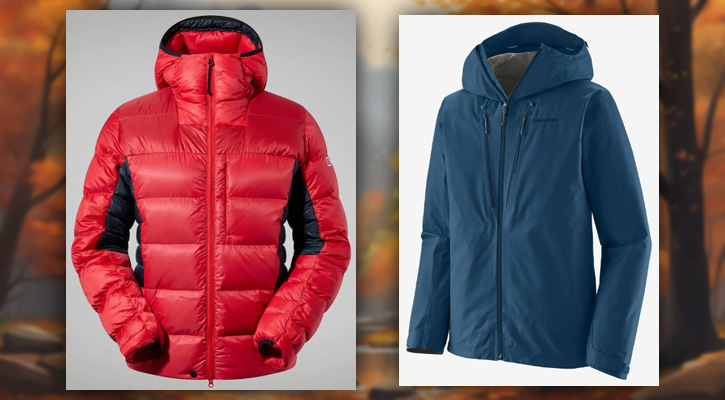
Berghaus and Patagonia are two brands that stand out for their reliable outdoor equipment.
Berghaus, with its roots in the rugged landscapes of the United Kingdom, has been outfitting explorers since 1966 with innovative designs like the Cyclops rucksack and the Gemini jacket.
Patagonia, born from the climbing culture of the American West, has become famous all over the world with its deep commitment to sustainability and quality gear.
Both brands have developed a range of technologies and materials aimed at enhancing your outdoor experience, but they also differ in their approaches and philosophies.
In this article, we explore their histories, products, and values to find out which is the better option and when.
Contents:
1. Berghaus Outdoor Gear
History of the Brand
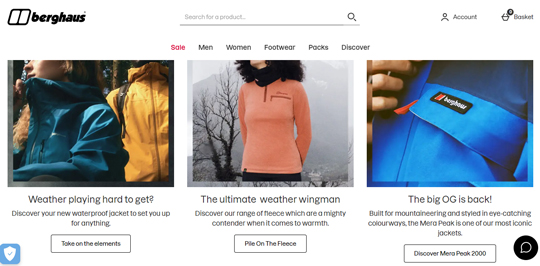
Berghaus official website
Berghaus Limited, a British brand, was created in 1966 in Newcastle upon Tyne, United Kingdom by Peter Lockey and Gordon Davison, both experienced climbers and mountaineers.
Initially known as LD Mountain Centre, the company transitioned to Berghaus in 1972 when the founders began producing their own outdoor products, starting with rucksacks. The Cyclops rucksack, featuring an innovative internal frame, was among their first designs.
Embracing Gore-Tex fabric early on, Berghaus became one of the first European brands to integrate it into their waterproof and breathable products in 1977.
The Gemini jacket, introduced in the 1980s, revolutionized the market by incorporating zip-in fleece for enhanced warmth and remains a popular product of the brand.
Renowned for their high-quality women’s, men’s, and children’s clothing and gear, Berghaus, meaning ‘mountain house‘ in German, has established itself as a leading brand in the UK over the years.
Don’t miss:
8 Alternatives to Berghaus: Our Favorites
8 British Outdoor Clothing Brands that We Love!
Materials, Fabrics, and Production Process
When it comes to the primary fabrics utilized by Berghaus and other famous outdoor brands, polyester and nylon stand out as the main materials. However, the key distinction lies in their sourcing. Many brands, including Berghaus, are increasingly prioritizing sustainable and environmentally-conscious production.
Berghaus, for instance, places significant emphasis on these principles. A substantial portion of the brand’s polyester is obtained from recycled plastic, thereby benefiting the environment without compromising the final product’s quality.
Also, the brand responsibly sources and fully traces the down insulation used, ensuring the humane treatment of birds and their overall well-being. This approach not only considers the welfare of ducks and geese but also guarantees the high quality of the sourced down.
As the first British brand to join the bluesign® system, Berghaus’ manufacturing process eliminates harmful chemicals. Moreover, Berghaus has developed Colourkind, an Eco fabric that conserves water and reduces chemical usage by 60% during the dyeing process. This method also ensures the fabric’s colorfastness and longevity, even after multiple uses.
In terms of technologies, Berghaus incorporates various options not only in its clothing designs but also in its footwear and rucksacks. Notable technologies include Gore-Tex, Polartec, Hydrodown, Pertex, and Hydroshell, among others.
The video will be loaded from YouTube.com, a third party. If you play it, you accept their terms of service, and their use of cookies.
Read also: Berghaus vs The North Face Outdoor Gear: A Comparison
Where is Berghaus’ outdoor gear made?
Some of the Berghaus’ equipment is manufactured in the United Kingdom, while a significant portion of their other merchandise is produced in Asian countries such as China and Indonesia.
Recommended Products
Berghaus Men’s MTN Arete Ultra Down Hoody
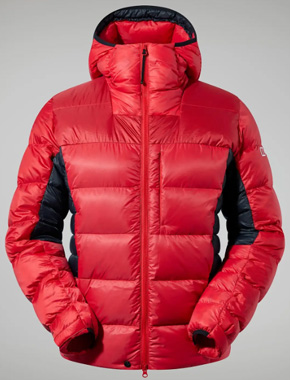
Image: berghaus.com
Check it out at Berghaus.com
The Berghaus Men’s MTN Arete Ultra Down Hoody has been specifically designed for harsh mountain conditions, prioritizing warmth, comfort, and resilience. Weighing only 440g for a UK large size, this jacket incorporates a three-zone body-mapped insulation system to ensure warmth without bulkiness.
The unique design features offset baffle construction with reflective technology to prevent cold spots and retain heat, stitch-through baffles for targeted breathability, and micro baffles for advanced temperature control. Reflect Technology has been integrated into the jacket to reflect body heat back towards the core, enhancing warmth.
Adjustability is facilitated with the through-pocket dual hem adjustment, and a dropped hem provides extra coverage. Safety is also taken into account with reflective detailing for visibility in low light conditions. The hoody’s insulation is powered by 850 fill-power Hydrodown, ensuring an exceptional warmth-to-weight ratio.
The jacket’s durability is improved with Liquid Crystal mapping in high-wear parts. For climbers, a helmet-compatible hood adds practicality and the jacket features a five-pocket design for ample storage. Lastly, a two-way front zip with an internal guard offers additional protection against the cold.
Don’t miss: Berghaus vs RAB: Which is Better?
Berghaus Unisex MTN Guide 45+ Backpack
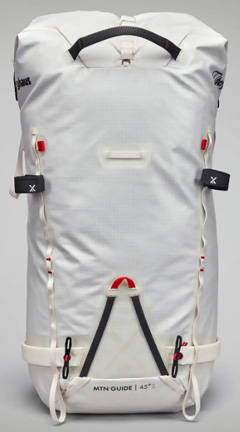
Image: berghaus.com
Check it out at Berghaus.com
The Berghaus Unisex MTN Guide 45+ Backpack is a versatile all-season mountain pack with a core volume of 45 liters, expandable for extended outings. Crafted from 400D recycled nylon and 600D polyester ripstop, it incorporates an external TPU coating for resilience and water resistance.
The backpack’s plastic elements are made from recycled nylon and are oversized. Weighing 1670g with all fixtures and 1150g when stripped, the MTN Guide 45+ prioritizes efficiency and adaptability. It boasts full back panel zip access for effortless gear retrieval, diverse carrying systems for axes and poles, a dedicated rope lashing system, and compatibility with a hydration reservoir of up to 3 liters.
The design encompasses daisy chain lashing for external gear attachment, reinforced haulage handles, and a unisex fit with a standard back length. The carrying system is customizable via a detachable hip belt and aluminum frame and includes a stashable mesh helmet holder for added convenience.
The detachable lid can be modified or removed to reduce weight or increase capacity, and the backpack is further fortified with bonded TPU patches to enhance durability.
Prices
Berghaus offers a various selection of prices for its gear with many affordable options. The price range for their jackets is $100 to $600, while their backpacks range from $50 to $250.
Are Berghaus products worth the price?
According to the feedback from outdoor enthusiasts who have tried and tested Berghaus’ jackets and gear, the brand is definitely worth it. They deliver great performance and good quality.
Must read: 9 Premium Hiking Brands for Clothing and Footwear
2. Patagonia Outdoor Gear
History of the Brand
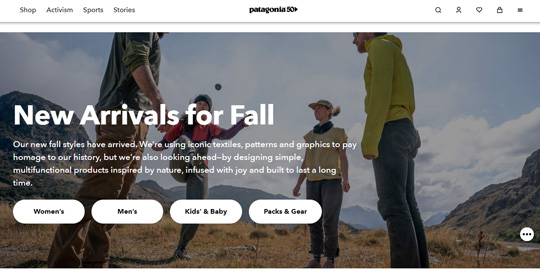
Patagonia official website
The history of Patagonia started in 1957 when the brand as we know it today still didn’t exist. In that year, the founder Yvon Chouinard, a passionate climber, decided to learn blacksmithing. He started by crafting and selling his first pitons to fellow climbers.
Later, Chouinard established a small workshop in Burbank to produce climbing gear, which he then distributed by traveling throughout California. An important collaboration with Tom Frost in 1965 resulted in the formation of Chouinard Equipment.
Following the division of Chouinard Equipment, Chouinard went on to establish Patagonia as a clothing brand in 1973.
Don’t miss:
9 Alternatives to Patagonia for Sustainable Clothing
12 American Outdoor Clothing Brands that We Love
Materials, Fabrics, and Production Process
At Patagonia, they think that every individual’s actions have a larger impact. As part of its commitment to sustainability, the brand uses recycled materials such as fishing nets, cashmere, wool, polyester, and cotton in its premium clothing.
Also, Patagonia, like Berghaus, uses Nylon and Polyester in their jackets and gear, along with advanced fabric technologies like H2No and Gore-Tex.
Recycled down is utilized for insulation against cold temperatures along with PrimaLoft synthetic insulation, and fabrics made with these technologies undergo thorough testing before being incorporated into the final product. You can find more information on Patagonia’s materials on its website.
The company is renowned in the outdoor community for its sustainability activism, ethical labor practices, and donations to environmental programs.
The video will be loaded from YouTube.com, a third party. If you play it, you accept their terms of service, and their use of cookies.
Read also: Mountain Hardwear vs Patagonia (Outdoor Gear Comparison)
Where is Patagonia outdoor gear made?
Patagonia primarily manufactures its outdoor gear in Vietnam, China, Sri Lanka, Mexico, Thailand, and several other nations, with a minor portion produced in the USA.
Recommended Products
Patagonia Triolet Men’s Jacket
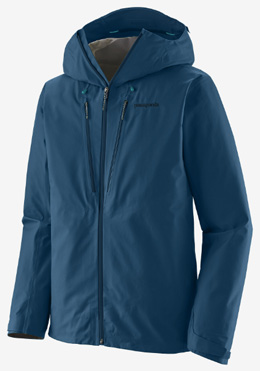
Image: patagonia.com
Check it out at Patagonia.com
The Triolet Men’s Jacket is made for harsh cold and snowy conditions. Built from a 3-layer GORE-TEX fabric, it offers waterproof, breathable, and windproof protection, complemented by a 100% recycled polyester external shell. The jacket is PFC-free and made in a Fair Trade Certified factory.
It features a helmet-compatible hood, two chest pockets with zips, two welted front pockets, and an interior drop-in pocket. Next, it includes welted, watertight two-way pit zips for ventilation and a dual-adjust drawcord hem to block out the elements. The jacket has a concealed RECCO® reflector for increased visibility and is made in Vietnam.
Read next: Lands’ End vs Patagonia Jackets (Side-by-Side Comparison)
Patagonia Terravia 28L Pack
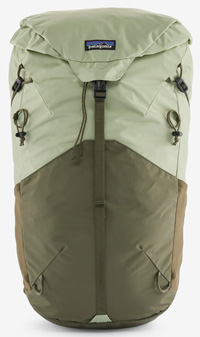
Image: patagonia.com
Check it out at Patagonia.com
The Terravia 28L Pack is a versatile backpack for day trips or slightly longer hikes. It offers a 28-liter volume and is made from durable 100% recycled nylon, combining strength with eco-friendliness. The backpack includes a highly breathable back panel and shoulder straps, a front-loading stuff pocket, and an automatic lid closure when the drawstring is pulled.
The suspended mesh back panel design ensures airflow and moisture prevention. The Regulator® airmesh shoulder straps and hip belt ensure a comfortable fit. Also, the backpack has easily accessible side pockets for small items and is compatible with hydration systems. It also comes with a rain cover and features zippered lid and internal security pockets for your belongings.
Don’t miss: The North Face vs Patagonia: Which is Better?
Prices
Patagonia is a premium brand and this is reflected in its prices which are expensive for many of its products. The price of their jackets ranges from $130 to $700, while the backpacks can be purchased from $70 to $300.
Are Patagonia products worth the price?
We think that the gear made by Patagonia is a good investment. They’re dedicated to using sustainable resources and advocating for environmental conservation, all this while creating durable and high-performance outdoor equipment.
Learn more: Why is Patagonia so Expensive? Is It Worth It?
3. Which is Better? Berghaus or Patagonia?
You can’t go wrong with either. Here are a few considerations to help you decide:
- Product Range: Berghaus is known for its wide range of outdoor apparel and equipment, including waterproof jackets, fleeces, and rucksacks. Patagonia also offers a broad selection of outdoor clothing and gear, with a strong focus on sustainability.
- Material Quality: Both brands are recognized for using high-quality materials. Patagonia is particularly known for its commitment to environmental sustainability and ethical manufacturing, often using recycled materials and organic cotton.
- Innovation: Berghaus has a history of innovation, particularly in waterproof and insulating technologies like their Hydroshell fabrics. Patagonia also invests in innovation, especially in developing and using sustainable materials. They have the H2No fabric technology for waterproof apparel.
- Sustainability: Patagonia is a leader in environmental activism and corporate responsibility. It is known for its commitment to the environment, fair labor practices, and transparency. Berghaus also has sustainability initiatives and ethical practices, but Patagonia is often more vocal and proactive in these areas.
- Prices: Both brands offer products that can be considered investment pieces because of their quality and durability. Patagonia’s prices are higher on average.
- Performance: The performance of outdoor gear from both brands is generally well-regarded by their customers.
- Style: Patagonia is known for its casual, outdoorsy style that is popular in both urban and outdoor settings. Its designs are more simple and with classic lines.
In the end, both brands are quite similar when it comes to their gear which has options for many outdoor activities. If you’re on a more limited budget, we recommend Berghaus. On the other hand, if you value sustainability, Patagonia is one of the best options in the market.
Read next: 8 Sustainable Outdoor Clothing Brands that You’ll Love!
